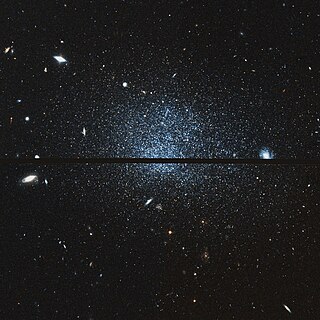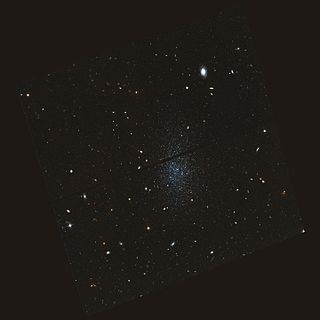Related Research Articles

The Local Group is the galaxy group that includes the Milky Way, where Earth is located. It has a total diameter of roughly 3 megaparsecs (10 million light-years; 9×1019 kilometres), and a total mass of the order of 2×1012 solar masses (4×1042 kg). It consists of two collections of galaxies in a "dumbbell" shape; the Milky Way and its satellites form one lobe, and the Andromeda Galaxy and its satellites constitute the other. The two collections are separated by about 800 kiloparsecs (3×106 ly; 2×1019 km) and are moving toward one another with a velocity of 123 km/s. The group itself is a part of the larger Virgo Supercluster, which may be a part of the Laniakea Supercluster. The exact number of galaxies in the Local Group is unknown as some are occluded by the Milky Way; however, at least 80 members are known, most of which are dwarf galaxies.

A dwarf galaxy is a small galaxy composed of about 1000 up to several billion stars, as compared to the Milky Way's 200–400 billion stars. The Large Magellanic Cloud, which closely orbits the Milky Way and contains over 30 billion stars, is sometimes classified as a dwarf galaxy; others consider it a full-fledged galaxy. Dwarf galaxies' formation and activity are thought to be heavily influenced by interactions with larger galaxies. Astronomers identify numerous types of dwarf galaxies, based on their shape and composition.

The Centaurus A/M83 Group is a complex group of galaxies in the constellations Hydra, Centaurus, and Virgo. The group may be roughly divided into two subgroups. The Cen A Subgroup, at a distance of 11.9 Mly, is centered on Centaurus A, a nearby radio galaxy. The M83 Subgroup, at a distance of 14.9 Mly, is centered on the Messier 83 (M83), a face-on spiral galaxy.

A dwarf spheroidal galaxy (dSph) is a term in astronomy applied to small, low-luminosity galaxies with very little dust and an older stellar population. They are found in the Local Group as companions to the Milky Way and as systems that are companions to the Andromeda Galaxy (M31). While similar to dwarf elliptical galaxies in appearance and properties such as little to no gas or dust or recent star formation, they are approximately spheroidal in shape and generally have lower luminosity.

Andromeda I is a dwarf spheroidal galaxy (dSph) about 2.40 million light-years away in the constellation Andromeda. Andromeda I is part of the local group of galaxies and a satellite galaxy of the Andromeda Galaxy (M31). It is roughly 3.5 degrees south and slightly east of M31. As of 2005, it is the closest known dSph companion to M31 at an estimated projected distance of ~40 kpc or ~150,000 light-years.

The Sculptor Dwarf Irregular Galaxy (SDIG) is an irregular galaxy in the constellation Sculptor. It is a member of the NGC 7793 subgroup of the Sculptor Group.

The Draco Dwarf is a spheroidal galaxy which was discovered by Albert George Wilson of Lowell Observatory in 1954 on photographic plates of the National Geographic Society's Palomar Observatory Sky Survey (POSS). It is part of the Local Group and a satellite galaxy of the Milky Way galaxy. The Draco Dwarf is situated in the direction of the Draco Constellation at 34.6° above the galactic plane.
Canes Venatici I or CVn I is a dwarf spheroidal galaxy situated in the Canes Venatici constellation and discovered in 2006 in the data obtained by Sloan Digital Sky Survey. It is one of the most distant known satellites of the Milky Way as of 2011 together with Leo I and Leo II. The galaxy is located at a distance of about 220 kpc from the Sun and is moving away from the Sun at a velocity of about 31 km/s. It is classified as a dwarf spheroidal galaxy (dSph) meaning that it has an elliptical shape with the half-light radius of about 550 pc.

The Antlia Dwarf is a dwarf spheroidal/irregular galaxy. It lies about 1.3 Mpc from Earth in the constellation Antlia. It is the fourth and faintest member of the nearby Antlia-Sextans Group of galaxies. The galaxy contains stars of all ages, contains significant amounts of gas, and has experienced recent star formation. The Antlia Dwarf is believed to be tidally interacting with the small barred spiral galaxy NGC 3109.

NGC 4236 is a barred Magellanic spiral galaxy located in the constellation Draco.

Holmberg IX is a dwarf irregular galaxy and a satellite galaxy of M81, located in the constellation of Ursa Major. It is of the Magellanic type of Galaxy as it is similar to the Small Magellanic Cloud, neighbour galaxy to Milky Way Galaxy. The galaxy is named after Erik Holmberg who first described it though it was first found by Sidney van den Bergh. Based on the observed age distribution of stars it contains, a whole 20% of its stellar mass formed within the last 200 Myr, making it the youngest nearby galaxy. It is also home to one of two yellow supergiant eclipsing binary systems.
Ursa Major II Dwarf is a dwarf spheroidal galaxy situated in the Ursa Major constellation and discovered in 2006 in the data obtained by the Sloan Digital Sky Survey. The galaxy is located approximately 30 kpc from the Sun and moves towards the Sun with the velocity of about 116 km/s. It has an elliptical shape with the half-light radius of about 140 pc.
Canes Venatici II or CVn II is a dwarf spheroidal galaxy situated in the Canes Venatici constellation and discovered in 2006 in data obtained by the Sloan Digital Sky Survey. The galaxy is located at a distance of about 150 kpc from the Sun and moves towards the Sun with the velocity of about 130 km/s. It is classified as a dwarf spheroidal galaxy (dSph) meaning that it has an elliptical shape with a half-light radius of about 74+14
−10 pc.
Coma Berenices or Com is a dwarf spheroidal galaxy situated in the Coma Berenices constellation and discovered in 2006 in data obtained by the Sloan Digital Sky Survey. The galaxy is located at the distance of about 44 kpc from the Sun and moves away from the Sun with the velocity of about 98 km/s. It is classified as a dwarf spheroidal galaxy (dSph) meaning that it has an elliptical shape with the half-light radius of about 70 pc.

KKs 3 is a dwarf galaxy in the Local Group. It is unusual because it is gas poor and very isolated in the halo of the local group. KKs 3 is about 7 million light years away from Earth. It is categorised as a dwarf spheroidal dSph galaxy. The mass of KKs 3 is 2.3 × 107M☉ (23 million times the mass of the Sun) with a blue absolute magnitude of −10.8. Three-quarters of its stars are over 12 billion years old. Coordinates are R.A. = 02h 24m 44.4s, Dec. = −73°30′51".
Triangulum II is a dwarf galaxy close to the Milky Way Galaxy. Like other dwarf spheroidal galaxies, its stellar population is very old: the galaxy was quenched before 11.5 billion years ago. It contains only 1000 stars, yet is quite massive, having a solar mass to light ratio of 3600. This is an unusually high mass for such a small galaxy.

KKR 03 is a dwarf irregular galaxy located 6.4 million light-years away from Earth. It has an absolute magnitude of −10.85 and lies on the inner edge of the M94 Group.

DDO 44 is a dwarf spheroidal galaxy in the M81 Group, believed to be a satellite galaxy of the nearby NGC 2403.
References
- 1 2 3 4 5 6 7 8 9 "Results for KKR 25". NASA/IPAC Extragalactic Database. Retrieved 2015-12-21.
- ↑ "KKR 25 dwarf spheroid galaxy". universetoday.com. December 22, 2014. Retrieved December 19, 2015.
- ↑ Makarov, Dmitry; Makarova, Lidia; Sharina, Margarita; Uklein, Roman; Tikhonov, Anton; Guhathakurta, Puragra; Kirby, Evan; Terekhova, Natalya (2012). "A unique isolated dwarf spheroidal galaxy at D=1.9 Mpc - INSPIRE-HEP". Monthly Notices of the Royal Astronomical Society. 425 (1): 709–719. arXiv: 1206.5545 . Bibcode:2012MNRAS.425..709M. doi: 10.1111/j.1365-2966.2012.21581.x . S2CID 22656416 . Retrieved December 19, 2015.
- ↑ Karachentsev, I. D.; Sharina, M. E.; Dolphin, A. E.; Geisler, D.; Grebel, E. K.; Guhathakurta, P.; Hodge, P. W.; Karachentseva, V. E.; Sarajedini, A.; Seitzer, P. (2001). "A new galaxy near the Local Group in Draco". Astronomy and Astrophysics. 379 (2): 407–411. Bibcode:2001A&A...379..407K. doi: 10.1051/0004-6361:20011344 .